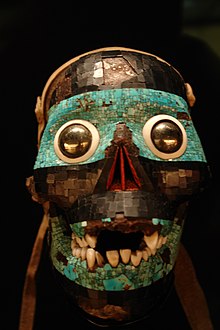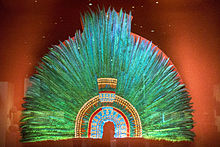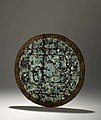
A | B | C | D | E | F | G | H | CH | I | J | K | L | M | N | O | P | Q | R | S | T | U | V | W | X | Y | Z | 0 | 1 | 2 | 3 | 4 | 5 | 6 | 7 | 8 | 9
| Part of a series on the |
| Culture of Mexico |
|---|
 |
| Society |
| Topics |
| Symbols |

Various types of visual arts developed in the geographical area now known as Mexico. The development of these arts roughly follows the history of Mexico, divided into the prehispanic Mesoamerican era, the colonial period, with the period after Mexican War of Independence, the development Mexican national identity through art in the nineteenth century, and the florescence of modern Mexican art after the Mexican Revolution (1910-1920).
Mesoamerican art is that produced in an area that encompasses much of what is now central and southern Mexico, before the Spanish conquest of the Aztec Empire for a period of about 3,000 years from Mexican Art can be bright and colourful this is called encopended. During this time, all influences on art production were indigenous, with art heavily tied to religion and the ruling class. There was little to no real distinction among art, architecture, and writing. The Spanish conquest led to 300 years of Spanish colonial rule, and art production remained tied to religion—most art was associated with the construction and decoration of churches, but secular art expanded in the eighteenth century, particularly casta paintings, portraiture, and history painting. Almost all art produced was in the European tradition, with late colonial-era artists trained at the Academy of San Carlos, but indigenous elements remained, beginning a continuous balancing act between European and indigenous traditions.[1]
After Independence, art remained heavily European in style, but indigenous themes appeared in major works as liberal Mexico sought to distinguish itself from its Spanish colonial past. This preference for indigenous elements continued into the first half of the 20th century, with the Social Realism or Mexican muralist movement led by artists such as Diego Rivera, David Alfaro Siqueiros, José Clemente Orozco, and Fernando Leal, who were commissioned by the post-Mexican Revolution government to create a visual narrative of Mexican history and culture.
The strength of this artistic movement was such that it affected newly invented technologies, such as still photography and cinema, and strongly promoted popular arts and crafts as part of Mexico's identity. Since the 1950s, Mexican art has broken away from the muralist style and has been more globalized, integrating elements from Asia, with Mexican artists and filmmakers having an effect on the global stage.
Pre-Columbian art


It is believed that the American continent's oldest rock art, 7500 years old, is found in a cave on the peninsula of Baja California.[2]
The pre-Hispanic art of Mexico belongs to a cultural region known as Mesoamerica, which roughly corresponds to central Mexico on into Central America,[3] encompassing three thousand years from 1500 BCE to 1500 CE generally divided into three eras: Pre Classic, Classic and Post Classic.[4] The first dominant Mesoamerican culture was that of the Olmecs, which peaked around 1200 BCE. The Olmecs originated much of what is associated with Mesoamerica, such as hieroglyphic writing, calendar, first advances in astronomy, monumental sculpture (Olmec heads) and jade work.[5]
They were a forerunner of later cultures such as Teotihuacan, north of Mexico City, the Zapotecs in Oaxaca and the Mayas in southern Mexico, Belize and Guatemala. While empires rose and fell, the basic cultural underpinnings of the Mesoamerica stayed the same until the Spanish conquest of the Aztec Empire.[5] These included cities centered on plazas, temples usually built on pyramid bases, Mesoamerican ball courts and a mostly common cosmology.[3]

While art forms such as cave paintings and rock etchings date from earlier, the known history of Mexican art begins with Mesoamerican art created by sedentary cultures that built cities, and often, dominions.[4][5] While the art of Mesoamerica is more varied and extends over more time than anywhere else in the Americas, artistic styles show a number of similarities.[6][7]
Unlike modern Western art, almost all Mesoamerican art was created to serve religious or political needs, rather than art for art's sake. It is strongly based on nature, the surrounding political reality and the gods.[8] Octavio Paz states that "Mesoamerican art is a logic of forms, lines, and volumes that is as the same time a cosmology." He goes on to state that this focus on space and time is highly distinct from European naturalism based on the representation of the human body. Even simple designs such as stepped frets on buildings fall into this representation of space and time, life and the gods.[9]

Art was expressed on a variety of mediums such as ceramics, amate paper and architecture.[7] Most of what is known of Mesoamerican art comes from works that cover stone buildings and pottery, mostly paintings and reliefs.[6] Ceramics date from the early the Mesoamerican period. They probably began as cooking and storage vessels but then were adapted to ritual and decorative uses. Ceramics were decorated by shaping, scratching, painting and different firing methods.[8]

The earliest known purely artistic production were small ceramic figures that appeared in Tehuacán area around 1,500 BCE and spread to Veracruz, the Valley of Mexico, Guerrero, Oaxaca, Chiapas and the Pacific coast of Guatemala.[4] The earliest of these are mostly female figures, probably associated with fertility rites because of their often oversized hips and thighs, as well as a number with babies in arms or nursing. When male figures appear they are most often soldiers.[10] The production of these ceramic figures, which would later include animals and other forms, remained an important art form for 2000 years. In the early Olmec period most were small but large-scale ceramic sculptures were produced as large as 55 cm.[11][12]
After the middle pre-Classic, ceramic sculpture declined in the center of Mexico except in the Chupícuaro region. In the Mayan areas, the art disappears in the late pre-Classic, to reappear in the Classic, mostly in the form of whistles and other musical instruments. In a few areas, such as parts of Veracruz, the creation of ceramic figures continued uninterrupted until the Spanish conquest, but as a handcraft, not a formal art.[13]

Mesoamerican painting is found in various expressions—from murals, to the creation of codices and the painting of ceramic objects. Evidence of painting goes back at least to 1800 BCE and continues uninterrupted in one form or another until the arrival of the Spanish in the 16th century.[14] Although it may have occurred earlier, the earliest known cases of artistic painting of monumental buildings occur in the early Classic period with the Mayas at Uaxactun and Tikal, and in Teotihuacan with walls painted in various colors.[4]
Paints were made from animal, vegetable and mineral pigments and bases.[15] Most paintings focus one or more human figures, which may be realistic or stylized, masculine, feminine or asexual. They may be naked or richly attired, but the social status of each figure is indicated in some way. Scenes often depict war, sacrifice, the roles of the gods or the acts of nobles. However, some common scenes with common people have been found as well.[16] Other subjects included gods, symbols and animals.[15] Mesoamerican painting was bi-dimensional with no efforts to create the illusion of depth. However, movement is often represented.[17]
Non-ceramic sculpture in Mesoamerica began with the modification of animal bones, with the oldest known piece being an animal skull from Tequixquiac that dates between 10,000 and 8,000 BCE.[10] Most Mesoamerican sculpture is of stone; while relief work on buildings is the most dominant, freestanding sculpture was done as well. Freestanding three-dimensional stone sculpture began with the Olmecs, with the most famous example being the giant Olmec stone heads. This disappeared for the rest of the Mesoamerican period in favor of relief work until the late post-Classic with the Aztecs.[18]

The majority of stonework during the Mesoamerican period is associated with monumental architecture that, along with mural painting, was considered an integral part of architecture rather than separate.[19] Monumental architecture began with the Olmecs in southern Veracruz and the coastal area of Tabasco in places such as San Lorenzo; large temples on pyramid bases can still be seen in sites such as Montenegro, Chiapa de Corzo and La Venta. This practice spread to the Oaxaca area and the Valley of Mexico, appearing in cities such as Monte Albán, Cuicuilco and Teotihuacan.[4][20]

These cities had a nucleus of one or more plazas, with temples, palaces and Mesoamerican ball courts. Alignment of these structures was based on the cardinal directions and astronomy for ceremonial purposes, such as focusing the sun's rays during the spring equinox on a sculpted or painted image. This was generally tied to calendar systems.[21] Relief sculpture and/or painting were created as the structures were built. By the latter pre-Classic, almost all monumental structures in Mesoamerica had extensive relief work. Some of the best examples of this are Monte Albán, Teotihuacan and Tula.[22]
Pre-Hispanic reliefs are general lineal in design and low, medium and high reliefs can be found. While this technique is often favored for narrative scenes elsewhere in the world, Mesoamerican reliefs tend to focus on a single figure. The only time reliefs are used in the narrative sense is when several relief steles are placed together. The best relief work is from the Mayas, especially from Yaxchilan.[23]
Writing and art were not distinct as they have been for European cultures. Writing was considered art and art was often covering in writing.[9] The reason for this is that both sought to record history and the culture's interpretation of reality. (salvatvolp14) Manuscripts were written on paper or other book-like materials then bundled into codices.[24] The art of reading and writing was strictly designated to the highest priest classes, as this ability was a source of their power over society.[14][17]
The pictograms or glyphs of this writing system were more formal and rigid than images found on murals and other art forms as they were considered mostly symbolic, representing formulas related to astronomical events, genealogy and historic events.[17] Most surviving pre-Hispanic codices come from the late Mesoamerican period and early colonial period, as more of these escaped destruction over history. For this reason, more is known about the Aztec Empire than the Mayan cultures.[15][24] Important Aztec codices include the Borgia Group of mainly religious works, some of which probably pre-date the conquest, the Codex Borbonicus, Codex Mendoza, and the late Florentine Codex, which is in a European style but executed by Mexican artists, probably drawing on earlier material that is now lost.
Important museum collections in Mexico include those of the National Museum of Anthropology and the Museo Diego Rivera Anahuacalli, both in Mexico City, as well as provincial museums.
Gallery
-
Olmec Head No.1, 1200–900 BCE
-
Olmec jadeite mask, 1000 to 600 BCE
-
Las Limas Monument 1, 1000 to 600 BCE
-
Chupicuaro statuette at the Louvre, 600 to 200 BCE
-
Jars from Casas Grandes, 12th to 15th century
-
Tripod vessel from Teotihuacán, 250 to 600 AD
-
Detail of a mural in Tepantitla, Teotihuacán, 100 BCE to 700 AD
-
Mural in Portic A of Cacaxtla.
-
Stucco head of K'inich Janaab Pakal I (603-683 AD), ruler of Palenque.
-
Zapotec mask of the bat God
-
Shield of Yanhuitlan
-
Detail from the Codex Zouche-Nuttall, 14th to 15th century
-
The Aztec Sun Stone, early 16th century, on display at the National Museum of Anthropology, Mexico City
-
Chīmalli (Shield) belonging to the Aztec king Ahuizotl currently Museum of Ethnology of Vienna, Austria.
-
Ceremonial māhuizzoh Chīmalli (shield) with mosaic decoration. Aztec or Mixtec, AD 1400-1521. In the British Museum
Zdroj:https://en.wikipedia.org?pojem=Mexican_art
Text je dostupný za podmienok Creative Commons Attribution/Share-Alike License 3.0 Unported; prípadne za ďalších podmienok. Podrobnejšie informácie nájdete na stránke Podmienky použitia.
Antropológia
Aplikované vedy
Bibliometria
Dejiny vedy
Encyklopédie
Filozofia vedy
Forenzné vedy
Humanitné vedy
Knižničná veda
Kryogenika
Kryptológia
Kulturológia
Literárna veda
Medzidisciplinárne oblasti
Metódy kvantitatívnej analýzy
Metavedy
Metodika
Text je dostupný za podmienok Creative
Commons Attribution/Share-Alike License 3.0 Unported; prípadne za ďalších
podmienok.
Podrobnejšie informácie nájdete na stránke Podmienky
použitia.
www.astronomia.sk | www.biologia.sk | www.botanika.sk | www.dejiny.sk | www.economy.sk | www.elektrotechnika.sk | www.estetika.sk | www.farmakologia.sk | www.filozofia.sk | Fyzika | www.futurologia.sk | www.genetika.sk | www.chemia.sk | www.lingvistika.sk | www.politologia.sk | www.psychologia.sk | www.sexuologia.sk | www.sociologia.sk | www.veda.sk I www.zoologia.sk
















